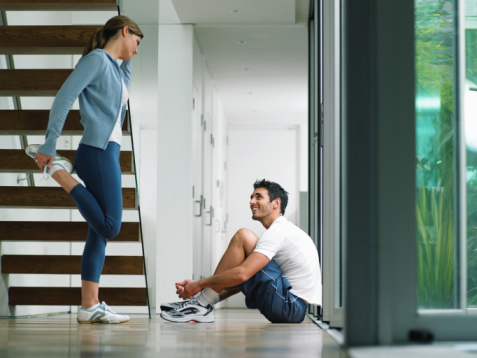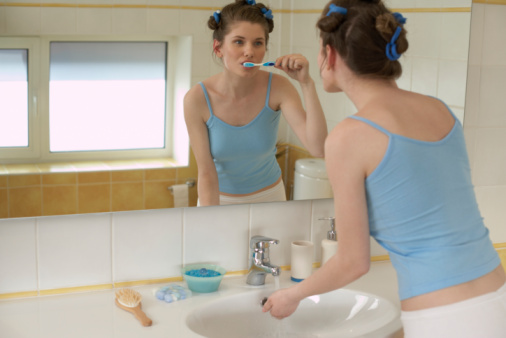Pelvic Floor Muscle Exercises
Bladder control depends on muscles working together when the bladder is filling: the bladder muscle should be relaxed and the muscles around the urethra (the tube that urine passes through) called the pelvic floor muscles should be tight. Exercises that strengthen the pelvic floor muscles can help hold urine inside the bladder, preventing leakage. These are commonly called "Kegel" or pelvic floor muscle exercises, named after the doctor who developed them.
 There are several ways to find your pelvic floor muscle. Women will feel a slight pulling in the rectum and vagina. When contracting the muscle, men will feel a pulling in of the anus and movement of the penis. Every person is unique, and different techniques work for different people.
There are several ways to find your pelvic floor muscle. Women will feel a slight pulling in the rectum and vagina. When contracting the muscle, men will feel a pulling in of the anus and movement of the penis. Every person is unique, and different techniques work for different people.
Technique #1 - Everyone, at one time or another has been in a crowded room and felt as if he or she were going to pass gas or "wind." Imagine that this is happening to you. Most of us will try to squeeze the muscles of our anus to prevent the passing of gas. The muscles being squeezed are the pelvic floor muscles. If you feel a "pulling" sensation at the anus, you are using the right muscles. In most of our patients, we have found this to be the most successful technique.
Technique #3 - For men, stand in front of a mirror and watch your penis. Try to make your penis move up and down without moving the rest of your body. If you can, you are using the right muscles.
Technique #2 - For women, lie down and insert a finger into your vagina. Try to squeeze around your finger with your vaginal muscles. You should be able to feel the sensation in your vagina, and you may also be able to feel the pressure on your finger. If you can, you are using the right muscles. If you cannot detect any movement with one finger, try two fingers.
You may not find your pelvic floor muscles immediately. Many people have to take their time with this.
Don't Exercise the Wrong Muscles!
One of the most common mistakes made is exercising the wrong muscle(s). When trying to find a new muscle, especially a weak one, most people tighten other muscles too. Some people clench their fists or teeth, hold their breath, or make a face. None of these help. It is very tempting to use other muscles, especially stronger ones, to support smaller, weaker muscles such as the pelvic floor muscles. However, using other muscles interferes with learning how to use the right ones. It is best just to relax your body as much as possible and concentrate on your pelvic floor muscles.
To avoid using your stomach muscles, rest your hand lightly on your belly as you are squeezing your pelvic floor muscles. Do you feel your belly tightening? If you do, relax and try again. Be sure that you do not feel any movement of your stomach.
If you find yourself holding your breath then you are probably using your chest muscles. First, relax completely and notice how you are breathing for a few moments. Then, squeeze your pelvic floor muscles while you continue to breathe normally. This will help to assure that you are not using your chest muscles because chest muscles are usually relaxed when you breathe.
The other set of "wrong muscles" are the muscles of the buttocks (bottom). To test whether you are also tightening your buttock muscles by mistake, squeeze your pelvic floor muscles while sitting in front of a mirror. If you see that your body is moving up and down slightly, you are also using your buttock muscles.
Another set of muscles used are the thigh muscles. If you see your upper legs moving which will cause your entire body to lift, you are contracting the wrong muscles. When done properly, no one should be able to tell that you are squeezing your pelvic floor muscles except for you.

Strengthening your Pelvic Floor Muscles
Once you have located your pelvic floor muscles and you are able to squeeze them without using your abdominal or buttock muscles, you are ready to begin your daily exercise program.
The reason for daily exercise is two fold. First, exercise increases the strength of your pelvic floor muscles, so that they will be strong enough to prevent urine leakage. Second, through repeated practice you gain control over these muscles. Then you can use them quickly to prevent urine loss or to decrease the urge feeling. These exercises are the mainstay of your program.
Each exercise consists of squeezing and then relaxing your pelvic floor muscles. Squeeze the muscles for three seconds and then relax the muscles for three seconds. It is common for most people not to take the time to relax between squeezes. You must allow the muscles to relax between squeezes so that your muscles can rest before squeezing again.
Doing Your Exercise Program
It is recommended that you complete at least two exercise sessions a day. Generally, do one set in the morning when you get up and one at night. Do sixty pelvic floor muscles every day, divided into two sessions of thirty exercises each. Remember, each squeeze and relaxation counts as one exercise. Do the exercises in each position every day; ten exercises lying, ten sitting, and ten standing. The exact time of day is not crucial. What is crucial is that you develop the habit of doing the exercises every day.
In the beginning, you will need to set aside time to concentrate while you do the exercises. Each time should be associated with a cue that will remind you to practice. For example, you may want to exercise just before you get up in the morning and before you fall asleep at night. Any activity that you perform regularly on a daily basis can be used as a cue.
- Lying down squeeze for 5 seconds and relax for 5 seconds, fifteen times
- Sitting down squeeze for 5 seconds and relax for 5 seconds, fifteen times
- Standing up squeeze for 5 seconds and relax for 5 seconds, fifteen times
You should build to 10 second contractions. Remember to squeeze and count slowly "1-2-3-4-5-6-7-8-9-10" and relax the muscle and count "1-2-3-4-5-6-7-8-9-10." Continue with forty-five exercises twice a day.

Using Your Pelvic Muscle to Control the "Urge"
Many people think that the only way to relieve the uncomfortable sudden feeling of urgency is to empty the bladder, but this is not so. Urges can come and go without you emptying the bladder; they are simply messages telling you that eventually you will need to urinate. In someone with overactive bladder, the urges are often false messages that you need to go now. Urges, however, should not be commands. They should function as an early warning system, getting you ready to find a place to urinate after you have relaxed and suppressed the urge.
To reduce or eliminate the urge to urinate, you will use your pelvic floor muscles. Remember to squeeze your pelvic floor muscles quickly several times when you get the urge feeling.
To do this, tighten/squeeze and relax the pelvic muscle as rapidly as possible. Do not relax fully in between squeezes. Try this now. Squeezing your pelvic floor muscles in this way sends a message to your nervous system and back to your bladder to stop contracting. As your bladder stops contracting and starts relaxing, the urge feeling subsides. Then, once the urge to urinate has subsided, you have a safe period when the bladder is calm. This "calm period" is the best time to go the bathroom.
These Exercises Cannot Harm You
These exercises are not harmful. You should find them easy and relaxing. If you get back pain or stomach pain after you exercise, you are probably trying too hard and using your stomach muscles. If you experience headaches, then you are also tensing your chest muscles and probably holding your breath. We do not recommend that you practice these exercises during urination by starting and stopping the flow of urine.
Pelvic floor muscle support usually improves within six weeks after starting the exercises, and three months should bring significant changes. However, symptoms improve slowly, so tracking symptom improvement is essential.
Making These Exercises Part of Your Life
Make the exercises part of your daily lifestyle so that exercising becomes a habit, almost like a reflex action! After six weeks of practice, the exercises will require less effort, and you will no longer need to set aside special times to concentrate on them. Tighten the muscle when you walk, before you cough, as you stand up, and on the way to the bathroom. Try to always tighten your muscle when you get a strong urge that you cannot control. Do your exercises when:
- standing at the sink and brushing your teeth
- you get up in the morning
- you are washing dishes
- putting on your make-up
- sitting in the car at a stop light
- sitting and having dinner
- reading a book in bed
- watching TV - during each commercial
- going for a walk
- talking on the phone
- having sex
Do your exercises during your daily activities or routines. You do not have to keep a formal count of the number of times you do each exercise just do it several times in a row. Do them often enough to make them a habit.
Content provided courtesy & permission of the American
Urological Association Foundation, and is current as of 5/2010.
Visit us at www.urologyhealth.org for additional information.
